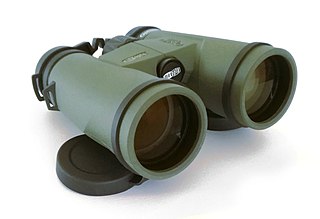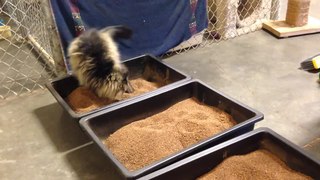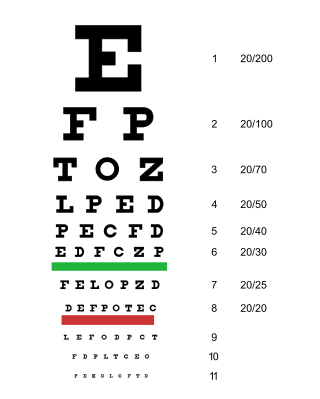
Binoculars or field glasses are two refracting telescopes mounted side-by-side and aligned to point in the same direction, allowing the viewer to use both eyes when viewing distant objects. Most binoculars are sized to be held using both hands, although sizes vary widely from opera glasses to large pedestal-mounted military models.

In biology, binocular vision is a type of vision in which an animal has two eyes capable of facing the same direction to perceive a single three-dimensional image of its surroundings. Binocular vision does not typically refer to vision where an animal has eyes on opposite sides of its head and shares no field of view between them, like in some animals.

A monocular is a compact refracting telescope used to magnify images of distant objects, typically using an optical prism to ensure an erect image, instead of using relay lenses like most telescopic sights. The volume and weight of a monocular are typically less than half of a pair of binoculars with similar optical properties, making it more portable and also less expensive. This is because binoculars are essentially a pair of monoculars packed together — one for each eye. As a result, monoculars only produce two-dimensional images, while binoculars can use two parallaxed images to produce binocular vision, which allows stereopsis and depth perception.

Depth perception is the ability to perceive distance to objects in the world using the visual system and visual perception. It is a major factor in perceiving the world in three dimensions. Depth perception happens primarily due to stereopsis and accommodation of the eye.

The field of view (FOV) is the angular extent of the observable world that is seen at any given moment. In the case of optical instruments or sensors, it is a solid angle through which a detector is sensitive to electromagnetic radiation. It is further relevant in photography.

A phantom limb is the sensation that an amputated or missing limb is still attached. It is a chronic condition which is often resistant to treatment. When the cut ends of sensory fibres are stimulated during thigh movements, the patient feels as if the sensation is arising from the non-existent limb. Sometimes the patient might feel pain in the non-existent limb. Approximately 80–100% of individuals with an amputation experience sensations in their amputated limb. However, only a small percentage will experience painful phantom limb sensation. These sensations are relatively common in amputees and usually resolve within two to three years without treatment. Research continues to explore the underlying mechanisms of phantom limb pain (PLP) and effective treatment options.

In optics, a Porro prism, named for its inventor Ignazio Porro, is a type of reflection prism used in optical instruments to alter the orientation of an image.

A scotoma is an area of partial alteration in the field of vision consisting of a partially diminished or entirely degenerated visual acuity that is surrounded by a field of normal – or relatively well-preserved – vision.

Image-stabilized binoculars are binoculars that have a mechanism for decreasing the apparent motion of the view due to binocular movement. Such binoculars are designed to minimize image shaking in hand-held applications. Higher-power binoculars magnify the image more, but the image shift is also increased. This means that even minor hand movements can cause huge image shifts. Image stabilization technology in binoculars ensures instant adjustment of the image to compensate for the motion. Major brands making image stabilized binoculars include Canon, Fujinon, Nikon, Carl Zeiss, and Bushnell.

An eye examination is a series of tests performed to assess vision and ability to focus on and discern objects. It also includes other tests and examinations pertaining to the eyes. Eye examinations are primarily performed by an optometrist, ophthalmologist, or an orthoptist. Health care professionals often recommend that all people should have periodic and thorough eye examinations as part of routine primary care, especially since many eye diseases are asymptomatic.
Phantom pain is a painful perception that an individual experiences relating to a limb or an organ that is not physically part of the body, either because it was removed or was never there in the first place.
Neuroplasticity, also known as neural plasticity or brain plasticity, is the ability of neural networks in the brain to change through growth and reorganization. It is when the brain is rewired to function in some way that differs from how it previously functioned. These changes range from individual neuron pathways making new connections, to systematic adjustments like cortical remapping or neural oscillation. Other forms of neuroplasticity include homologous area adaptation, cross modal reassignment, map expansion, and compensatory masquerade. Examples of neuroplasticity include circuit and network changes that result from learning a new ability, information acquisition, environmental influences, pregnancy, caloric intake, practice/training, and psychological stress.
Neuroprosthetics is a discipline related to neuroscience and biomedical engineering concerned with developing neural prostheses. They are sometimes contrasted with a brain–computer interface, which connects the brain to a computer rather than a device meant to replace missing biological functionality.
A finnstick is the name given by birdwatchers to a stick used to support a binoculars. The one end of the stick is steadily attached to the binocular while the other end rests against the belly.
Sensory processing is the process that organizes and distinguishes sensation from one's own body and the environment, thus making it possible to use the body effectively within the environment. Specifically, it deals with how the brain processes multiple sensory modality inputs, such as proprioception, vision, auditory system, tactile, olfactory, vestibular system, interoception, and taste into usable functional outputs.
Body schema is an organism's internal model of its own body, including the position of its limbs. The neurologist Sir Henry Head originally defined it as a postural model of the body that actively organizes and modifies 'the impressions produced by incoming sensory impulses in such a way that the final sensation of body position, or of locality, rises into consciousness charged with a relation to something that has happened before'. As a postural model that keeps track of limb position, it plays an important role in control of action.

Proprioception is the sense of self-movement, force, and body position.

Allochiria is a neurological disorder in which the patient responds to stimuli presented to one side of their body as if the stimuli had been presented at the opposite side. It is associated with spatial transpositions, usually symmetrical, of stimuli from one side of the body to the opposite one. Thus a touch to the left side of the body will be reported as a touch to the right side, which is also known as somatosensory allochiria. If the auditory or visual senses are affected, sounds will be reported as being heard on the opposite side to that on which they occur and objects presented visually will be reported as having been presented on the opposite side. Often patients may express allochiria in their drawing while copying an image. Allochiria often co-occurs with unilateral neglect and, like hemispatial neglect, the disorder arises commonly from damage to the right parietal lobe.
The globe effect, also known as rolling ball effect, is an optical illusion which can occur with optical instruments used visually, in particular binoculars or telescopes. If such an instrument is rectilinear, or free of rectilinear distortion, some observers get the impression of an image rolling on a convex surface when the instrument is panned.

A Perger prism or Perger–Porro prism system is a prism, that is used to invert an image. The special feature of this prism is that, like a traditional double Porro prism system, it manages this with only four beam deflections and has neither a roof edge with the accompanying phase correction problems, a mirrored surface or an air gap. However, in contrast to the traditional double Porro prism, it leads to a significantly reduced eyepiece/objective axis offset. The reduced beam offset allows for slimmer, more straight binocular housings usually found in roof prism binoculars. Complicating production requirements make high-quality roof prism binoculars relatively costly to produce compared to in optical quality equivalent Porro prism or "Perger–Porro prism system" binoculars.












